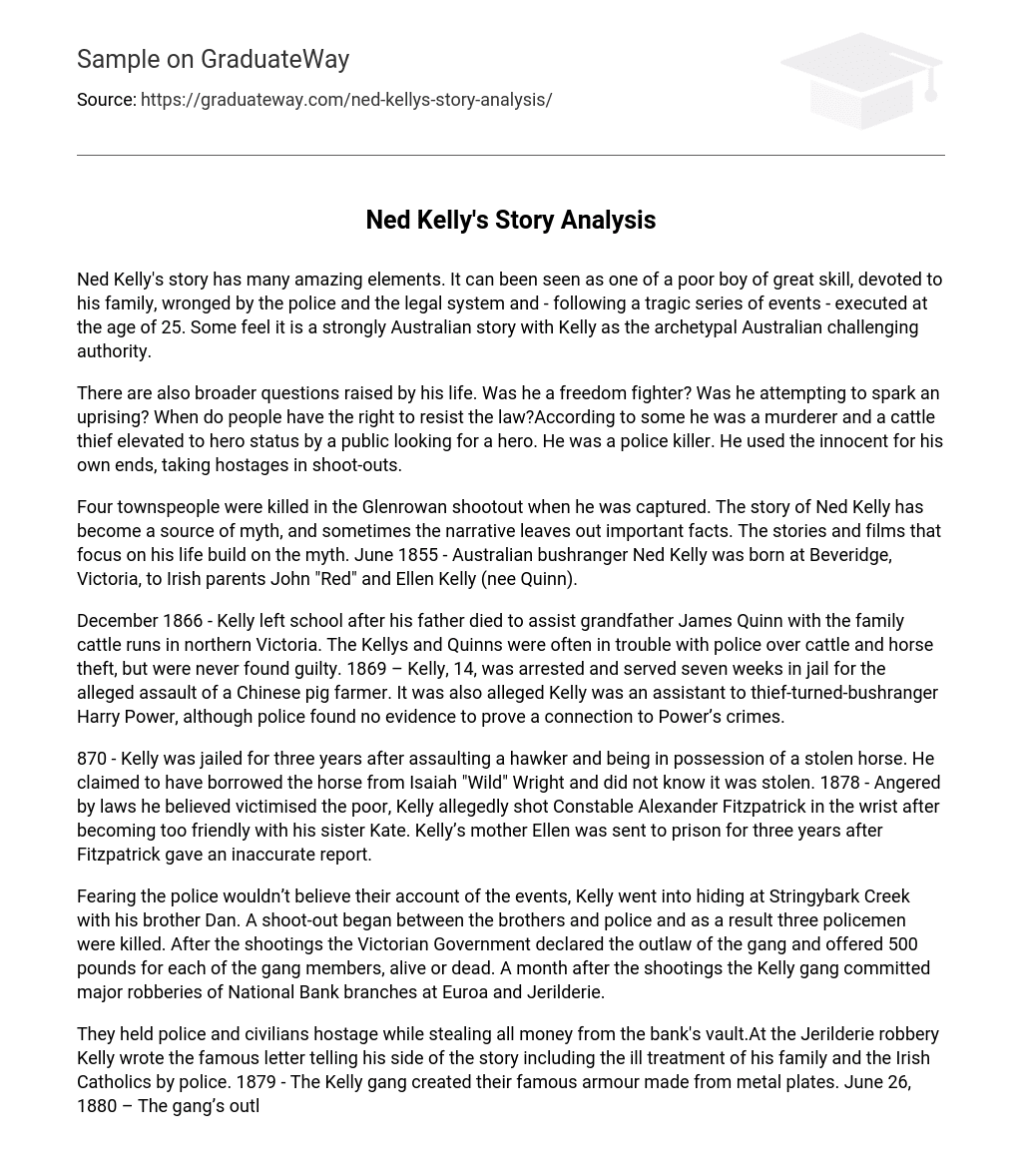Ned Kelly’s narrative is filled with remarkable aspects. It can be viewed as the tale of a skilled impoverished youth fiercely loyal to his family, unjustly treated by law enforcement and the judicial system, and ultimately, after a tragic sequence of events, put to death at the young age of 25. There are those who perceive it as a quintessential Australian story, depicting Kelly as the iconic Australian figure defying authority.
The life of this individual also raises broader questions. Was he a freedom fighter or someone attempting to incite rebellion? When is it justified to defy the law? Some people saw him as both a murderer and cattle thief, while others later hailed him as a hero that society desperately needed. He caused the deaths of police officers and manipulated innocent people to achieve his own aims, even resorting to hostage situations during gunfights.
Four townspeople were killed in the Glenrowan shootout during Ned Kelly’s capture. His story has become a legendary source, often neglecting crucial details. The narratives and movies about his life further develop this myth. In June 1855, Australian bushranger Ned Kelly was born in Beveridge, Victoria, to Irish parents John “Red” and Ellen Kelly (nee Quinn).
Kelly left school to help his grandfather James Quinn with the family’s cattle runs in northern Victoria after his father died. The Kellys and Quinns frequently got into trouble with the police for stealing cattle and horses, but they were never convicted. In 1869, at the age of 14, Kelly was arrested and spent seven weeks in jail for supposedly attacking a Chinese pig farmer. There were also claims that Kelly worked as an accomplice to the thief-turned-bushranger Harry Power, but the police couldn’t find any evidence linking him to Power’s criminal activities.
870 – Kelly was sentenced to three years in jail for assaulting a hawker and having a stolen horse. He argued that he had borrowed the horse from Isaiah “Wild” Wright and was unaware it was stolen. 1878 – Fueled by his belief that laws unfairly targeted the impoverished, Kelly purportedly shot Constable Alexander Fitzpatrick in the wrist as he had become overly familiar with Kelly’s sister Kate. Due to Fitzpatrick’s misleading report, Kelly’s mother Ellen was imprisoned for three years.
Kelly and his brother Dan sought refuge at Stringybark Creek due to their belief that the authorities would not believe their account. During a confrontation with law enforcement, the siblings engaged in gunfire, resulting in the demise of three officers. Subsequently, the Victorian Government branded the gang as outlaws and offered a reward of 500 pounds for each member, regardless of whether they were apprehended deceased or alive. Roughly one month later following the altercation, the Kelly gang executed notable heists at National Bank branches located in Euroa and Jerilderie.
During the Jerilderie robbery, the Kelly gang took police and civilians hostage and stole all the money from the bank’s vault. It was during this robbery that Kelly wrote the famous letter, which detailed the mistreatment of his family and Irish Catholics by the police. In 1879, the gang created their iconic armor using metal plates. On June 26, 1880, after their outlaw status expired, the group shot and killed Aaron Sherritt, who had once been a friend but had become a police informer.
On June 28, 1880, the gang, who had been holding 70 people captive at the Glenrowan Inn, discovered that a train carrying police to their location was en route. In an attempt to derail the train, Kelly ordered the tracks to be torn up. However, their plan proved unsuccessful as one of the hostages managed to escape and inform the authorities. Consequently, a shootout between the police and the gang ensued, lasting nearly twelve hours.
Shortly after this, the Kellys relocated to Glenrowan where a teenage Ned began engaging in petty crimes, specifically targeting affluent landowners. According to the tale, Ned Kelly’s decision to become a bushranger was influenced by the unfavorable perception of his family by the authorities. When a group of policemen started targeting him, he retaliated and made the conscious choice to live a life outside the law.
In order to give them a legitimate reason, he decided to be charged with something. Kelly became the apprentice of Harry Power, a well-known bushranger in Victoria. Power had been transported to Van Diemen’s Land in 1841 for stealing shoes and upon his release, he continued a life of crime, eventually ending up in Pentridge Gaol. It was after his escape from Pentridge in 1869 that he became a bushranger.
Initially, he worked alone but eventually decided that he wanted a partner. Jack Lloyd, a friend of his, introduced his nephew, 15-year-old Ned Kelly, who was already disgruntled by constant encounters with law enforcement. Lloyd suggested Ned Kelly to Harry Power. Power then became a mentor to Ned Kelly, welcoming him as an apprentice in 1870 and imparting the intricacies of bushranging.
Ned Kelly escalated his criminal activities, starting with minor offenses and eventually committing more serious and violent crimes such as bank robbery and murder. As a result, he became a fugitive, constantly pursued by authorities. According to http://wiki.answers.com/Q/Why_did_Ned_Kelly_become_a_bushranger, the Kelly family, including Ned Kelly, had numerous encounters with the law before, which shaped their opposition to imperialism.





